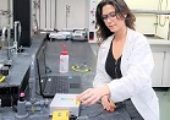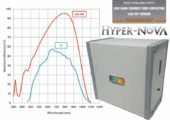The word “laser” is an acronym that stands for “light amplification by stimulated emission of radiation.” Lasers have two main components: a cavity made by two mirrors that reflect light between them and a gain medium that sits inside the cavity.

Energy is pumped into the gain medium to promote electrons to higher levels. Then some electrons decay through spontaneous emission in all directions. Some of the photons hit the cavity mirrors, so that they are reflected back at the gain medium. The reflected photons cause stimulated emission in the gain medium and create more photons traveling between the mirrors that stimulate the emission of even more photons. The photons (light) are amplified through the process of stimulated emission. If one of the cavity mirrors is partially reflective, some of that light can exit the cavity to be used as a light source in a spectroscopy experiment. Most importantly, because of the stimulated emission process, laser light is spacially and temporally coherent. StellarNet uses lasers for Raman & Fluorescence spectroscopy applications





